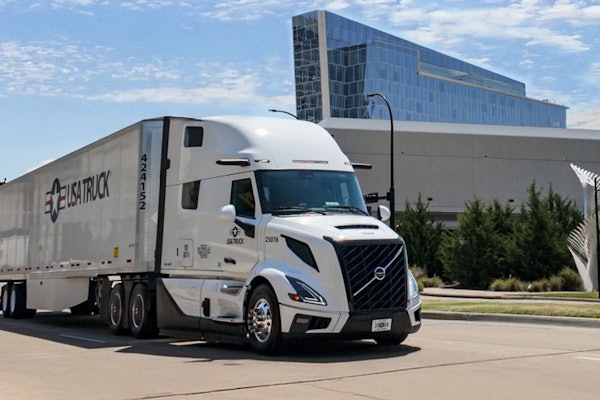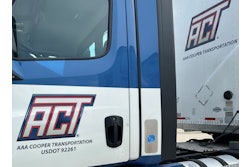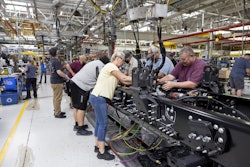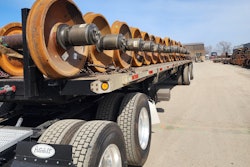A small segment of carriers buy most of their capacity from used truck dealers and auctions. With long lead time for new trucks, are there opportunities to expand your fleet or meet capacity demands by buying used?
When Mike Limbaugh and Nick Tolleson started White Oak Transportation with four trucks in 1999, their business plan relied on used trucks to meet capacity demand. Six years later, the Decatur, Ala.-based carrier is thriving, running 155 of its own trucks and using 45 owner-operators. And even though they have the heft to afford new power units, the company still buys used.
“For us, it’s as much about risk as anything,” explains Limbaugh, White Oak’s co-owner and chief operating officer. “We can match our equipment payments to the length of our freight contracts.”
Used equipment always has been a path toward inexpensive capacity and has, therefore, been a refuge for small carriers and owner-operators. But with long waits for new trucks – getting a new Class 8 road tractor from the factory can take as long as nine months – other carriers are eyeing the market.
According to a recent survey of CCJ readers, more than a third of fleet owners buy some number of used trucks as part of their normal purchasing routine, and more than 10 percent buy used trucks exclusively. Are there opportunities for your trucking company at the used truck lot – especially in this period of tight capacity? The answer to that depends on the risks you’re willing to take, the strength of your shop staff and the immediacy of your capacity needs.
State of the market
As recently as four years ago, used truck dealers had trouble moving equipment.
Overproduction in the late 1990s, a pre-buy before the October 2002 technology change, fleet-friendly trade-in policies and record numbers of bankruptcies all contributed to a glut of late-model, low-mileage Class 8 units. When dealers spoke of low-mileage units, they were talking about premium spec’d sleeper units with 350,000 to 450,000 miles and often younger than four years old. And there were plenty of trucks available, keeping prices down.
Now, those trucks are in short supply and carry a premium price. “There’s a shortage of used trucks in certain models,” says Eddie Walker, president of the Used Truck Association and owner of Eddie Walker’s Best Used Trucks in Fort Worth, Texas. “Lower mileage used to be 200,000 miles and down. Then it got to 500,000 miles and down. Now it’s 600,000 miles and down. If you can find some 550,000 and down and 600,000 and down, it’s probably a low-mileage truck. And there’s getting to be a shortage of those.”
With fewer bankruptcies – and, hence, fewer repossessions – among owner-operators and small fleets and with larger carriers hanging onto trucks longer, the average mileage on used trucks has gone up dramatically.
“There are plenty of used trucks available on the open market today,” says Lee Wallace, senior vice president of sales and marketing for Arrow Truck Sales. “However, buyers must be very flexible on the mileages that are acceptable to them. The average Class 8 used truck that Arrow sells has increased in mileage by more than 70,000 miles over the past 24 months. Used trucks with 600,000 miles and above are readily available.”
Trucks in the 500,000 range are much harder to find, and trucks under 500,000 with good specifications are scarce, Wallace says.
This is true for both highway tractors and daycabs. Quality medium-duty trucks also are hard to find, says Scott Pearson, Peterbilt assistant general manager. “Daycabs are the hottest units on the used market, but so are medium-duty units. Those trucks just don’t sit very long once they come back in on trade.”
Typically, fleet trade cycles have fed low-mileage trucks to used dealers and auctions, but lately carriers have kept their trucks past traditional three- and four-year trade cycles. Many carriers were avoiding new, lower-emission engines. Others have delayed trading, hoping to save money by running equipment longer.
“There’s definitely fewer of those trucks,” says Freightliner SelecTrucks President Bill Gordon. “The slightly older truck with higher miles is more available – trucks that are four to five years old and over 550,000 miles. It really is the result of major fleets finding that the trucks can accumulate additional miles without extraordinary costs in repairs. They’re also reluctant to order new trucks in substantial number.”
Other factors that have lengthened the trade cycle are fleets holding trucks because of the lead times getting new trucks and owner-operators worried about an increased truck payment when the price of fuel is high and may be rising, Gordon says.
As supply has dipped, price has gone up: A five-year-old owner-operator spec’d truck – which cost $110,000 new – with 500,000 miles on it can cost more than $50,000, depending on condition and options. Used truck dealers say prices are in line with new trucks, which now can cost more than $150,000 with similar specs. In the last two years, Wallace says the average mileage on used trucks that Arrow turns over has gone up 70,000 miles – and the average price has gone up $7,000.
The shortage of 3- to 4-year-old trucks also is impacting auction supplies. “That whole market has dried up considerably,” says Paul Wachter, president of auctioneer Taylor & Martin. “We used to have a lot of repossessions, but that market has gone down dramatically.”
Benefits
Still, there are bargains to be had, and some fleets that traditionally buy new now are looking at used trucks. Wachter says there are several reasons for this change:
- The price of new trucks has made used trucks more attractive. “They aren’t willing to pay the high price for a new truck,” he says.
- Some carriers are leery of adding new capacity in the face of an uncertain economic future.
- Carriers need units quickly. “Deliveries are out quite a ways. That has created a draw towards the used truck market.”
“New trucks are so expensive,” says Bobby Wolford, owner of Bobby Wolford Trucking in Woodinville, Wash. He just bought six used Kenworth T800s, all spec’d for severe duty. He plans to keep one of the trucks for his 20-truck fleet and sell the other five. Price was a factor. “A new truck with this spec would have cost me $165,000. All of these were less than $50,000.”
Lead time also was a major factor. Wolford needs the one truck immediately, and ordering a new truck would take five months, he says. With a strong freight market, even large fleets are seeing used trucks as a way to meet capacity demands immediately.
“There are some very large fleets that buy used trucks from Arrow,” Wallace says. “We have sold more than 100 units to two of the top 10 U.S. public carriers in the past six months. We sold 30 trucks to one of the largest private fleets within the last six months.” Those companies bought used vehicles in order to meet immediate demands that could not be satisfied by new units or for a contract that was short-term in nature, Wallace says.
The demand for new trucks is so great – and the wait time so long – that one carrier that supplies parts to a Peterbilt factory is having trouble getting enough units to move freight. “This was a typical case,” Pearson says.
Other carriers are being cautious with their expansions, and buying used trucks allows those carriers to mitigate the risk. If a lane fails to develop or if freight dries up, the carrier has less capital tied up in equipment. That’s one of the reasons White Oak Transportation has continued to buy used: The company can write its freight contracts and finance its used equipment for three-year stints, matching freight to the work, Limbaugh says. “There’s just less risk that way,” he says. “The truck’s paid for.”
Having equipment that’s paid for is a big advantage for small carriers, too. Wolford says he can pay cash for used equipment. “I have equity, and I can put them right to work right away,” he says.
Drawbacks
Although used trucks are cheaper to buy, are generally available and offer less upfront risks, there are drawbacks. Limbaugh, for example, says White Oak probably wouldn’t buy used if the company’s trucks went to the West Coast from its Alabama base. Risk of breakdowns and the cost of repairs at truck stops would reduce any financial advantage offered by used trucks. Instead, White Oak Transportation sees its units every day and can address mechanical problems in its own shop. It keeps four technicians on staff and has two independent contractors on hand for repairs. Its short routes, averaging about 400 miles, are covered easily if a failure strands a load.
Mechanical problems were one of the reasons why the Raben Tire Company stopped buying used trucks across its entire fleet of 225 power units. Ryan Brown, risk and fleet manager for the Evansville, Ind. firm, says the company once bought used equipment – from half-ton pickups to Class 8 tractors – and would replace them “when the wheels finally fell off.
“But we changed our maintenance practices,” Brown says. “We did not want to continue to make the kind of maintenance investment necessary for those kinds of trucks. When you buy a used truck, you don’t really know what you’re getting. You have to staff yourself for the unknown.”
Since many used trucks come with little or no warranty, the burden is on the carrier to maintain and repair the equipment. Most used truck dealers offer extended warranties on drive train components, but those warranties only will repair the truck – they can’t repair business relationships.
Owner-operators may be more comfortable with used equipment because they can do the mechanical work themselves. “I usually buy used equipment, but that’s because I have a diesel mechanic on staff and I can handle almost all the routine maintenance and repairs,” says Harlyn Barnes, owner of H B Trucking in Paducah, Ky. “I don’t recommend buying used unless you have the ability to work on trucks or a reliable mechanic on staff. I know how to work on them, what they need and how to get the parts I need.”
Another challenge with used trucks: driver retention and recruiting. Carriers often use equipment to lure drivers. Older units obviously have less appeal – at least for large-fleet drivers. On the used market, smaller fleets actually can afford used trucks that have attractive features – like classic styling and big bore engines – that they could not afford on new tractors.
Despite these concerns, however, carriers are finding capacity in the used market. “More and more fleet buyers are buying 550,000- or 600,000-mile trucks with the belief that the truck has substantial life left in it,” says SelecTrucks’ Gordon.
UTA’s Walker agrees. “High mileage doesn’t hurt a truck,” he says. “The lack of maintenance does.”
For carriers like White Oak Transportation, getting extra miles out of used trucks is a smart business proposition. The company is set up to repair the trucks it buys, but it makes sure the trucks it buys are unlikely to have many problems.
“It works out well for our balance sheet,” Limbaugh says.
Leasing used trucks
Buying isn’t the only way to acquire a used truck these days. White Oak Transportation, for example, has 30 leased units in its fleet – all used trucks. Mike Limbaugh, co-owner and chief operating officer, says the company is leasing some of its units to keep from owning too much equipment. But the terms of the lease also allow it to match equipment to freight contracts.
White Oak’s trucks come from a Freightliner SelecTrucks leasing program, which offers leases from 24 to 30 months, SelecTrucks President Bill Gordon says. “It’s a structured, fair-market value lease. It’s a nice program for a fleet that knows it’s got demand for that equipment for a short period of time but doesn’t want to make a commitment to new trucks or a longer-term lease.”
What appears to be driving interest in short-term used equipment is tight capacity, Gordon says. With shippers unable to get all their loads covered using their traditional carriers, smaller carriers are finding never-before-seen – but possibly temporary – opportunities for freight.
The used truck lease can be combined with a maintenance contract to create, in effect, a full-service lease, Gordon says. Or it can be left unbundled for carriers who want to repair and maintain their own units. Small carriers aren’t the bulk of the lease business, either. The typical lease transaction size for SelecTrucks is between 10 to 50 trucks.
The lease generally is for matched units: A carrier will take on trucks that all have similar miles and specs. “What they’re really after is consistency in the units – everything from the same source fleets,” Gordon says.
SelecTrucks started its lease program two years ago and added the contract maintenance option last year. The company sees a long-term market for leased trucks, but Gordon admits it’s probably a niche.
Shopping for a used truck
If you’re looking at used trucks for the first time, finding out everything you can about the units you’re buying is essential, says Used Truck Association President Eddie Walker. “Do your homework. Ask where it came from and what maintenance has been performed on it. Know the truck, its service history and the availability of warranty.”
Most used truck dealers will allow your mechanic to inspect units – if they don’t, run, don’t walk away from the dealer, Walker says. Other advice:
- Shop a number of dealers.
- Look at the number of trucks sold by a dealer. “If he is turning equipment over quickly, he’s probably selling a pretty decent truck,” Walker says.
- Check out the number of hours on the unit, in addition to the mileage. A low-mileage truck may have a high number of idle hours, making it much older than it looks.
- On trucks with 600,000 miles, check the front-end suspension and bushings, says Lee Wallace, senior vice president of sales and marketing for Arrow Truck Sales. Even the rears may be wearing out.
- Look for units with remaining transferable warranties on key components, or large dealers that offer extended warranties and have a network to service those warranties, says Scott Pearson, assistant general manager for Peterbilt.
- Contact the previous owner and find out the vehicle’s maintenance history.









